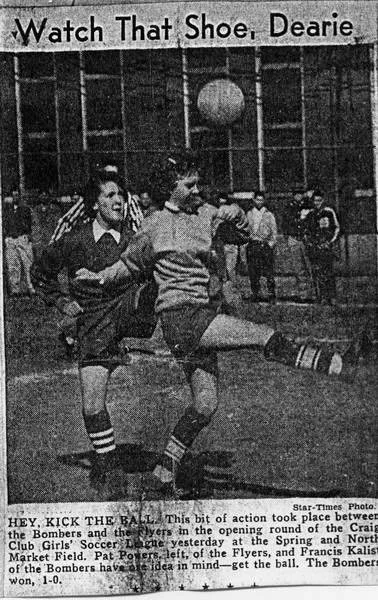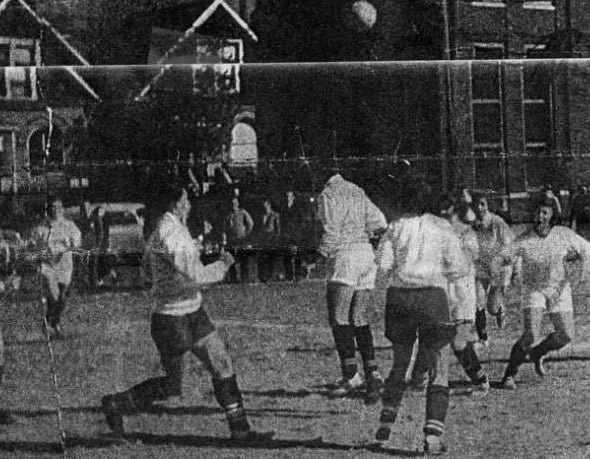Kicking Back: Not Just a Footnote
Writing about American soccer history is a fool’s errand most of the time, especially the further back in history one is looking. Sure, there’s youtube videos and websites dedicated to MLS, but go deeper than the 90’s and things get murkier by the year. The mid 70’s NASL has some love, thanks to the star power of Pele and the other European stars who brought fans and coverage to the game, but once the research departs that era, writers are left with box scores and the occasional article, but little else. The fans of sports history focused on the big three American sports: baseball, football, and basketball. Soccer was oftentimes seen as a game kids and immigrants played and the facts that filter through the years are limited. If the men’s game is hard to find facts about, multiply the difficultly by researching the women’s game.
Early History of the Women’s Game
Women have fought throughout modern history to gain an equal footing in the sporting world. While the modern version of soccer has multiple top flight women’s leagues across the world, history tells the story of an uphill battle for women to get an opportunity to play the game as their male counterparts. In the early 20th century, as women’s football was beginning to gain notoriety and fan interest in England, the FA announced that the sport was “quite unsuitable for females.” Aside from passing judgement on women’s participation, the announcement also encouraged clubs to ban women from playing on their grounds, effectively ending any chance of the women’s game growing. That rule remained in place in England until the 1970s.
The one exception to the rule was the famous Dick, Kerr Ladies team that toured widely, including in the United States. In Dave Litterer’s article, The History of Women’s Soccer: Part 1, he discusses an American tour by the team of talented women soccer players. When the team arrived in the United States, it was discovered that there were no women’s teams to play against. So the club “resolved to play against men’s teams, and these included some of the top teams in the country.” Patterson FC, J&P Coates, Fall River Marksmen, and New Bedford Whalers all faced the women’s side. The tour ended with the club taking home a 3-3-3 record against the men’s sides, some of the best clubs of the era. Dick, Kerr Ladies FC continued to play soccer, regardless of the FA’s claims of it being “unsuitable,” until the mid 1960’s.
Dick, Kerr Ladies FC from the 1922 US Tour.
In the United States, the game was not outlawed, per se, but women were certainly discouraged from playing sports, oftentimes on the grounds of outdated, 19th century pseudoscientific claims. Dr. Edward Clarke in 1874 claimed that “both muscular and brain labor must be reduced at the onset of menstruation.” This claim, and others like it, was used to thwart women’s interest in any game deemed unladylike. Soccer, along with every other sport, was a man’s game for the first half of the 20th century. And, if you accepted the absence of documentation as proof of a lack of existence, you might believe there was no women playing the game until the mid 1970s (collegiately). But there’s a blip on many American soccer timelines, almost a footnote, that mentions Craig Club Soccer League in 1950.
Bobby Soccers’ players before a match. Dorothy “Dot” Gilliam is front row, center in the Craig Club shirt.
Soccer-Mad St. Louis
Craig Club Soccer League (CCSL) was founded in 1950 in St. Louis by a priest, Walter Craig. The fact that the league was founded in St. Louis should be no surprise to soccer history fans. St. Louis has been a soccer-mad place for more than a century, and the CCSL is an important part of the city’s soccer story. The same year this fledging women’s league was founded, the 1950 U.S. Men’s National Team would feature a large representation from the city, including the keeper, Frank Borghi. The city was rich in soccer talent and women were an equal part of that pool.
“It was over, but it was fun while it lasted.”
In his book, Soccer Made in St. Louis: A History of the Game in America's First Soccer Capital (Reedy Press), Dave Lange discusses how the league came to be. With a surplus of funds in the parish treasury, Fr. Craig had to find a way to spend them or they would be confiscated by the archdiocese. The Craig Club was founded with the goal of sponsoring athletic teams. While men’s clubs were also sponsored, the women’s league was the most “novel” of the spending. “The Craig Club Soccer League began play on Sundays in 1951 with women ages sixteen to twenty-two, drawn mostly from St. Mathew’s and St. Teresa’s.”
League Play
Dave Lange’s work is especially great because of his first hand accounts of one of the players in this league, Dorothy “Dot” Gilliam, who played for the Bobby Soccers. Her quotes are wonderful. “We didn’t want to be treated differently, we wanted to play the game the way it was supposed to be played.” She tells the story of having to play in an almost unplayable field, due to heavy rainfall, “because all the men wanted to see us fall on our face in all that mud.”
In Mark Dent’s 2015 article, Thirty Years Before Abby Wambach Was Even Born, These Women Pioneered Soccer in America, in Slate, he discusses how Walter Craig opened the women’s league for anyone, “no matter her race, religion, or neighborhood.” That first group of 70 players was divided into four teams for the 1950 season: the Bobby Soccers, the Coeds, the Flyers and the Bombers. Information about the matches, like a box score, is tough to come by. For his article on the league, Dent spoke with several players from the CCSL who talked about the league and the level of play.
“There were some Sundays when they would cancel the men’s games and they would never cancel ours,” she [Flo Murphy] told me. “To see if we could tough it out, I guess.” For shin guards, Bobby Soccers team captain Mary Dwyer stuffed issues of Reader’s Digest into her socks. “We were a motley looking crew,” Dwyer said. “I’ll tell you that.”
The matches brought fans, some for the novelty and some for the gameplay, with newspapers from the time reporting crowds in the hundreds. One article from the time described a match in language that implied the casual sexism that permeated the culture at the time. “Although far from expert in the sport, the girls played with enthusiasm and determination. Wearing usual soccer uniforms and playing with a regulation ball and under men’s rules, they chased up and down the field, intent on a single purpose-scoring a goal. Bruises and scratches attested the roughness of the play; only serious injury was a fractured ankle.”
A typical headline from the time.
It’s clear that many writers in the local press saw the women’s league as a sideshow, not equal to men’s side of the game. In a period article by Marion Milton in the Star-Times, Milton describes the league as a “novel experiment,” rather than treating the match with much respect. In the same article, the writer describes the tactical side of the match as “team or position play didn’t mean much to the girls.” Regardless, the newspaper writers continued to show up to the matches and write about the results. No doubt that coverage was significant to the growth of the league.
After the first season, the league was popular enough that players began to join from outside the original neighborhoods. However, after the second season, the league fell apart. Lange’s book quotes Gilliam on the reasons - “It just fell apart, for one reason or another…some girls went off to college, some got married and got pregnant, things like that. There wasn’t any interest in anyone behind us coming up in school who wanted to carry on. It was over, but it was fun while it lasted.”
Photo from a newspaper in that era.
After the 1951 season, the league ceased to exist and the first women’s league in the United States was confined to history books and the memories of a few soccer history nerds. But the lack of a lasting impact doesn’t make the women that filled the league’s rosters any less groundbreaking. As Mark Dent put it, the CCSL “was a huge leap forward for women's sports that deserves major recognition.” These were women and girls playing a sport a locally-loved sport but without the praise, admiration, or respect they deserved. They are not footnotes in American soccer history, they are iconoclasts and heroes, people who deserve to be praised for their dedication to the sport they loved. In a quote from Lange’s book, Dot sums it up. “It was something that I don’t think I’ll ever forget. We were like pioneers in women’s soccer. It’s amazing to me to see how far it’s come and what a wonderful opportunity it’s become for women.”
The Actual Footnote
If there is a footnote to the story, it is one that is sadly predictable and incredibly timely, considering recent stories around the women’s game. Walter Craig, founder of the Craig Club Soccer League and a member of the St. Louis Soccer Hall of Fame, is highlighted for his work with St. Louis youth. In an online history for the church he served in, his focus on sports is mentioned as a key in his work: “under the leadership of Fr. Walter Craig, who served as Pastor from 1949 to 1954, the parish continued to grow. He built a new gym facility to provide activities for 200 boys and girls. The gym consisted of a basketball court, hoc-soc field soccer, and four billiard tables.” That legacy however, is somewhat overshadowed by another search result. The priest was accused of sexually abusing a boy in the 1960’s. According to multiple sources, in 2013, the diocese of Springfield-Cape Girardeau announced that Craig was credibly accused of sexual abuse. Craig died in 1971 and the accusations became public decades after his passing.
- Dan Vaughn
Credit to Mark Dent, Dave Lange, and Jim Leeker who were all incredibly helpful in researching this piece.



